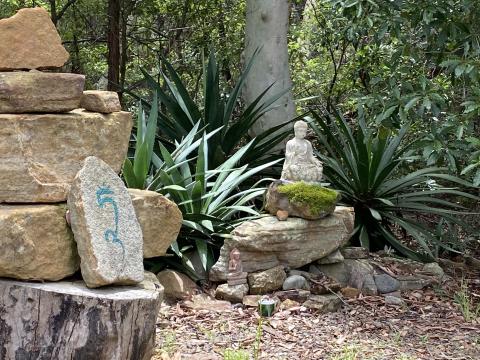
November wellbeing newsletter - How can meditation help with handling stress?
I've just returned from seven days on a predominantly silent meditation retreat. The week's focus was exploring one of the Buddha's pieces of training called Anapanasati. Anapana means the act of breathing in and breathing out. And sati means "with" mindfulness.
The training also focussed on the concept of impermanence, change and agility. To get a handle on impermanence, consider the entire lifespan of a Mayfly is 24 hours or reflect on the length of time British Prime Ministers spend in office.
Over the last twenty years, I've been on many similar retreats, and each time I come away refreshed and learning a new insight into how to apply mindfulness to modern challenges.
I appreciate my great fortune and luck in being able to take the time to do these things. Many of my friends, colleagues and clients are so time-poor, lack the resources or have home and work commitments that stretch themselves to the limit and beyond. And many other people are suffering in the face of a cost-of-living crisis, and neither have the time, money, ability or inclination to step back and pause.
The program was south of Sydney in the beautiful national park. These were the highlights (I imagine that for many of you, this would be your definition of hell!):
- No phones, no internet for a week
- Most of the week spent in total silence
- Seven hours per day of guided meditations
- Vegan food
I've probably lost a few people at that point! I can imagine you have some questions:
- "Why would you take your intention inside yourself for so long. Isn't it a bit self-centred"?
- "Why would you put yourself through such a challenge? The world is here to be enjoyed."
- "What's the point of focussing on your breathing? We all do it; it's natural."
- "It's self-centred - how does it help others if you feel calm and Zen-like?"
Watch the breath
Although your breath flows in and out in its own sweet way, our breathing pattern changes depending on our emotional, physical and energy landscape. For example, when we notice we’ve made a significant error in a report, our cheeks might become flushed, and our breathing becomes faster and jagged.
Lengthen the breath
The first part of anapanasati training is observing and deepening the breath. How might you do that at work? For example, before a meeting, you could take a few seconds to breathe in through the nose and out through the mouth, imagining that you are breathing out slowly through a straw. Then, feel the breath moving against your lips.
Or try this - place a hand on your abdomen and imagine there is a ball in that place. As you breathe in, the ball gets bigger and bigger, rising to your neck and shoulders. And then completely empty the lungs slowly. Imagine you are about to pitch to a new client and feel nervous. Ground yourself by feeling the back of your legs on the ground and your feet on the floor, and then practice deepening your breath.
Do these things habitually - not just when you feel stressed. For example, get into a habit of grounding yourself with a breath before starting any new conversation with a colleague. And as you add a small circuit breaker, develop some positive internal self-talk – “I breathe in. I breathe out. I’m here to listen to Jon”, etc.
Use the breath to own your emotions
Next, use the breath to explore the sensations in your body. For example, as you breathe, you might notice that you feel tense in your abdomen or shoulders. Deliberately choose to use the breath to soften the sensations you are feeling. You might use more positive self-talk such as, “Anxiety is here. It’s ok to feel these things. Anybody else would feel the same way if they had to talk to senior executives”, etc.
Accurate labelling of your emotions coupled with physical activity, such as deepening the breath and having a positive internal kindly voice, help us understand and navigate our emotions. Notice I used the term “anxiety is here” rather than “ I am anxious”. The first term is transitory and impermanent. The second is rigid and inaccurately and detrimentally locks permanency to our emotional states.”
Get into the habit of accurate emotional labelling before meetings. It will help you step back and step up and connect with your colleagues.
Returning to the questions
“Why you would take your intention inside yourself for so long. Isn’t it a bit self-centred”?
Research by Amish Jha, Richard Davidson and other neuroscientists point to significant improvements in people’s abilities and behaviours with just 10 to 15 minutes of meditation a day, resulting in progress in the following areas: focus, ability to handle pain and stress and emotional agility.
However, a trait like change to our wellbeing and behaviours takes time. Longer immersive meditation retreats result in profound changes in how people respond to stress. Daily meditation practice, intensive, immersive retreats and applying mindfulness in everyday workplace routines result in profound benefits. People become more resilient, calmer, and optimistic, become better listeners and have better self-awareness about their emotional triggers, strengths, and weaknesses.
Key takeaway - do a little every day. Set a timer and meditate on the breath for at least 10 minutes a day. And learn to embed mindfulness at work and home by talking mini two second timeouts.
“Why would you put yourself through such a challenge? The world is here to be enjoyed.”
There is no doubt that going on these courses is challenging. At the start, I missed home, felt guilty about all the work I was missing and was anxious about the emails piling up.
But quite quickly, my mind and body relaxed, and with that space, I experienced profound creative insights into my home and work life. I don’t think these valuable gifts would have happened in an average working week.
And denying myself my regular diet, friends and family and so on made me appreciate those things so much. During the week, I experienced deep and intense moments of love and gratitude for the people in my life. A week of solitude has made me feel more joyful and connected to my job and the people I love. If we continue to satiate our desires, we can become bored and restless for new things rather than truly appreciating what we have already.
Key takeaway - set yourself a goal which is tough, causes you some discomfort, connects you to others and helps you learn some new skills. And stick to the program. See it out. It’s the tough things which are often the most valuable.
“What’s the point of focussing on your breathing? We all do it, it’s natural”
Our body reacts to changes to mental stimuli – when we feel stressed, our breathing pattern changes, and we may become aware of other sensations, such as heat or tightness in the chest. Likewise, when we feel connected to a colleague and overcome a challenge together, our bodies pattern differently; we trust each other, our oxytocin levels rise, and we feel soothed by each other’s company.
Our minds, the neural circuitry of our brains, our bodies, and the people around us constantly listen and affect each other in a dance of awareness. For example, the tone of voice you speak to me alerts me to a potential threat or soothing. If you are harsh, my body may react in a fight-flight response to defend myself from a potential threat. But, on the other hand, when you speak calmly and make soft eye contact, I feel held, and my mind, brain and body feel assured and connected.
Our breathing and the sensations we feel in our body are excellent barometers of our wellbeing, level of interpersonal trust and effectiveness. For example, turning your attention to your breathing might reveal that a throwaway comment by a colleague has angered you. When you practise some breathing techniques, as I mentioned earlier, you connect the awareness of the physical reaction (your breath shortens) and the stimulating event (a comment that you perceived as rude). As you actively engage in deeper and slower breathing, you engage the parasympathetic rest and restore response. This has many advantages, including:
You can engage in top-down logical rather than emotionally reactive bottom-up thinking – this helps you consider the bigger picture, what is within your area of control and how best to respond to a colleague.
Rest and restore enables our brains to engage in deep critical thinking and helps us be more creative – in rest and restore, the brain makes fantastic tangential connections and perceives problems through fresh filters. In fight-flight, our brains focus on our immediate tasks and threats.
Applying a self-soothing breathing technique at a pinch point enables you to connect the outcome (my body feels stressed) to the activating event (my colleague often speaks abruptly when he is in that situation) – which can build wisdom and insight. For example, you might have an aha moment such as, “wow, when my colleague feels out of their depth, they seem to lash out. I’ve over-personalised their behaviour and have reacted badly to this in the past. What can I do to help them?”
Practising mindfulness of the breath attunes your attention to become more aware of the connections between mind, brain, body and our interactions with our environment. And practice leads to greater self-awareness and deepens our ability to connect wisely with colleagues and friends.
Key takeaway – listen to your breath and your body and have a deliberate intention to be kind to yourself. “My body is reacting because I feel threatened. That’s ok, its normal. I’ve got some tools to learn more about that which help me set strong boundaries, build self-compassion and connect with people.”
“It’s self-centred – how does it help others if you feel calm and Zen like?”
Being a coach, workshop facilitator, and business owner mean spending a lot of time listening. Deep listening can be energising, stimulating as well as tiring. However, listening well requires practice. And it starts with listening to ourselves.
People use my services for many reasons, but often it’s down to experiencing uncertainty about how to proceed and make a decision, time pressure and a feeling of tightness and constriction.
Creating space inside helps us feel more open to change and possibility. If I feel tight, stressed and constrained, that rubs off on my clients. One of our jobs as leaders, colleagues and friends is to help others feel space, and we can do that by cultivating more space in ourselves.
Key takeaway – self-care at work is not just a "nice to have" but a "must have". I started this article by saying that I'm lucky. A parent with three kids and a demanding leadership role would rightly scoff at the idea of taking time for themselves to build space inside. Mindfulness is not a panacea for fixing all the dysfunctionality of a modern workplace. Still, it does provide a 2,500-year-old toolbox containing practical techniques which help people feel more centred, agile and joyful. If you need help and support learning more about mindfulness at work, reach out to me, and I'll explain more.



